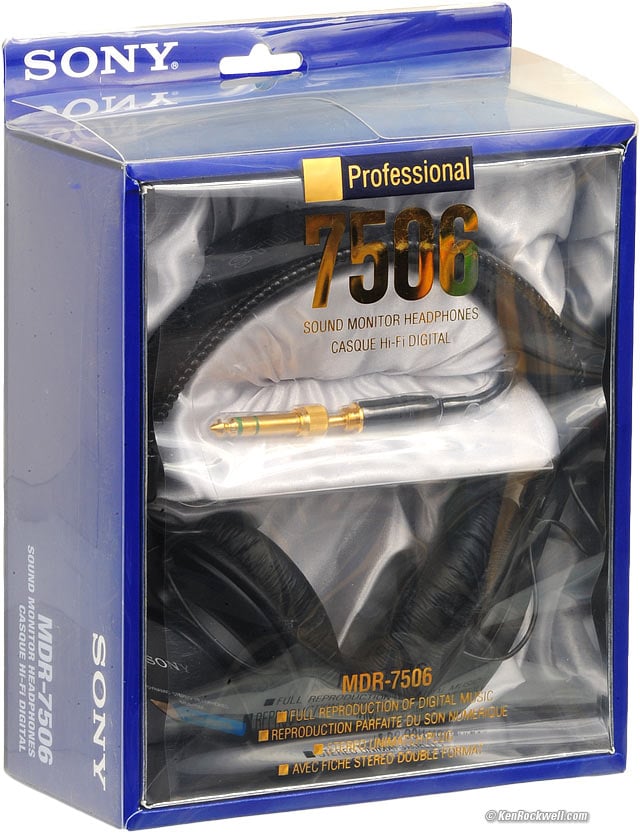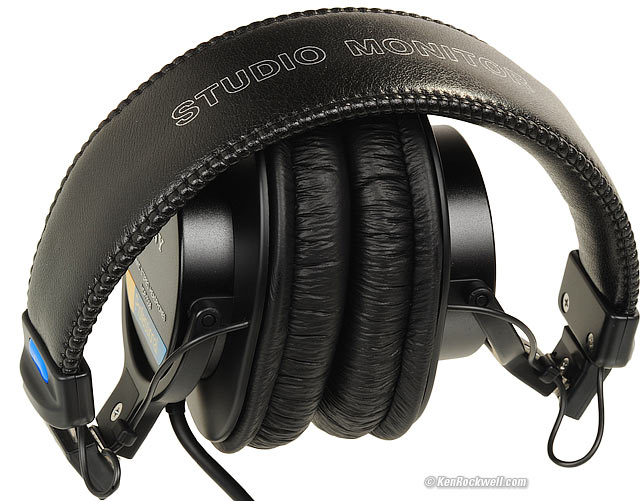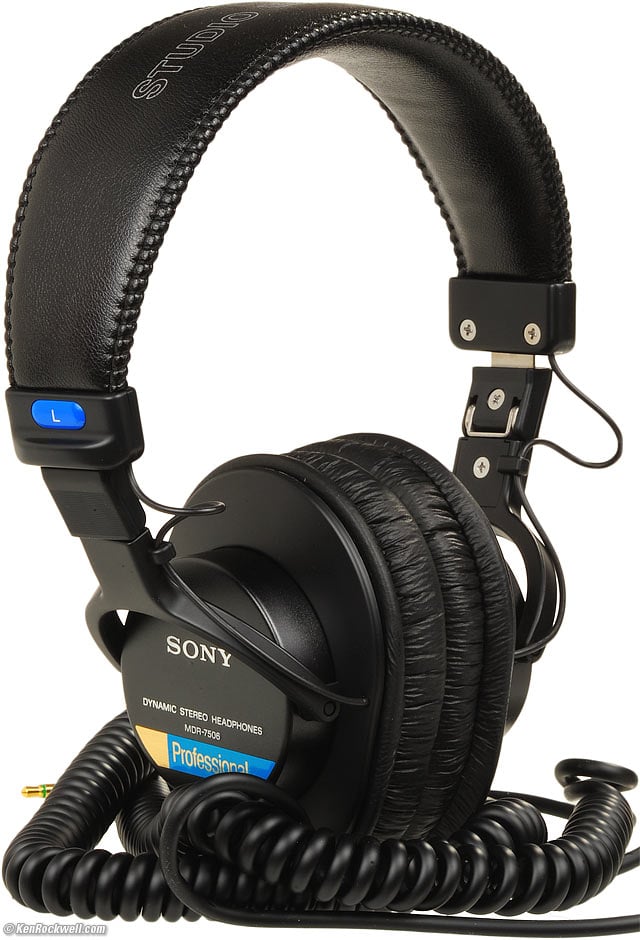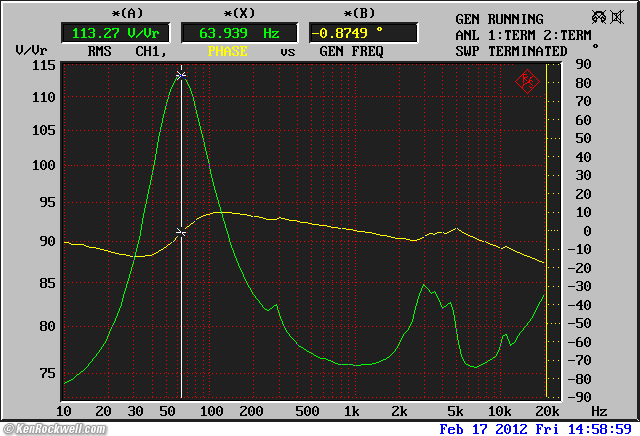Home Donate New Search Gallery Reviews How-To Books Links Workshops About Contact
Sony MDR-7506
World's Most Popular Pro Headphones
© 2012 KenRockwell.com. All rights reserved.
Intro Specs Performance Recommendations
Sony MDR-7506. larger. (8.1 oz./230g without cord, about $99). larger. This free website's biggest source of support is when you use these links, especially this link directly to them at Adorama, at Amazon or at B&H, when you get anything, regardless of the country in which you live. Thanks! Ken.
December 2012 All Reviews > Audio Reviews > Headphone Reviews > Sony Reviews
Introduction top
Intro Specs Performance Recommendations
|
Adorama pays top dollar for your used gear. I use these stores. I can't vouch for ads below.
|
The Sony MDR-7506 is an extremely sensitive, closed, isolating headphone that's great for travel and monitoring professional field recordings — especially DSLR video.
The MDR-7506 has been the world's most popular professional headphone for many decades, and it's just a slight cosmetic variation on the previous Sony MDR-V6 that's been around since the late 1970s!
No kidding: when I worked in radio in the late 1970s through early 1980s, all my friends carried their Sony MDR-V6 to the shows they DJed. (I preferred the less expensive, American-made Koss 4AA.) Back when digital audio was just being invented by Sony, Sony would tie down all their MDR-V6 and MDR-7506 headphones to their latest professional digital audio recorders on display at the AES shows to amaze us with the quality of digital sound. In fact, that's why the MDR-V6 says FOR DIGITAL all over it.
This MDR-7506 is the same as the classic MDR-V6, differing only in saying PROFESSIONAL instead of DIGITAL on the side, and by plating the connector a gold, instead of nickel, color.
Sony isn't telling, but my numbers confirm that Sony actually sells at least tens of thousands of these MDR-7506 every month!
Why is the MDR-7506 so popular today, and why has it been so popular for at least the past thirty years?
Because it's small, light, rugged, sounds pretty good, is extremely sensitive for use with DSLRs, iPods and portable digital and video recorders, reasonably priced, it does a good job at isolating outside noise, it leaks very little sound to the outside, folds for carrying, and you even can flip over the earpieces to use just one side at a time held to your head if you're singing in a studio with live performers.
Whew. For just under $100 brand new, Sony can't pump out the MDR-7506 fast enough. These are exceptionally popular in TV and DSLR video; next time you see a video cameraman, he's probably wearing a pair of these to monitor his audio — honest.
These MDR-7506 excel for field use to be sure that your audio is clear, that you have no noise or rumble and that no one is cursing quietly in the background. The MDR-7506 are the best and most abuse-proof headphones there are for making sure you got good audio while you are still recording it.
At under $100, the MDR-7506 are swell for enjoying music, especially from iPods and iPads, and are tough and fold for carrying and isolate outside sound, however they don't have the sound quality of more expensive headphones. Specifically, they do have a moderate midrange peak, but have unusually clean, deep and extended bass response without any booming.
35,000 audio professionals each month can't be that wrong, and these are well built to take a beating, so they last quite a while being sat on out in the field. The gimbal pivots are stainless steel, and the plug is metal, not crappy plastic like far more expensive headphones from Beyer and Ultrasone.
The MDR-7506 are designed to be repaired, and even include a profusely illustrated parts list inside the box as a "service manual."
Sony got it right with the MDR-V6 and MDR-7506: when I compared these MDR-7506 to the newest MDR-7502, MDR-7510 and MDR-7520 in 2012, the MDR-7506 still sound better, and usually cost less. These newer headphones all have nastier midrange peaks.
The plug is pure genius, and has been for over thirty years: it's a 3.5mm plug, with a screw-on ¼" adapter for use with professional gear. With the adapter screwed-on, it's as good as a real ¼" metal plug. The adapter is interchangeable with the screw-in adapters that come with most Beyer headphones, too.
Specifications top
Intro Specs Performance Recommendations
Technology
Around-the-ear, isolating closed headphones.
40mm diameter driver.
Neodymium Magnet
16 µm diaphragm.
Copper-clad aluminum voice coil.
Oxygen copper litz wire cable.
Fake leather around-the-ear pads.
Impedance
63 Ω at 1 kHz, rated.
Measured Impedance
Sony MDR-7506 measured Impedance magnitude (Ω), and phase angle versus frequency. (R&S UPL; +90º is capacitive, -90º is inductive.)
Measured impedance is about 80 Ω, with a maximum of 113 Ω at 64 Hz and minima of about 76 Ω at 1 kHz and 7 kHz. Phase angle varies from -13.8º at 33.1 Hz, +10º at 123.5 Hz to -17.1º at 20 kHz.
Sensitivity
106 dB SPL at 1 milliwatt.
1 mW at a rated 63 Ω is 251 mV.
At 1 volt, this would be 118 dB SPL.
At 100 mV, this would be 98 dB SPL.
Power Handling
500 mW rated.
1 watt maximum.
Yikes! That's 133 dB SPL rated, 136 dB SPL maximum. 120 dB causes pain, and anything over 115 dB SPL can cause immediate and permanent hearing damage.
Frequency Range
10 ~ 20,000 Hz, no conditions specified.
Cord and Plug
Coiled.
3 meters (10 feet) when extended.
3.5mm plug with "Unimatch" screw-in ¼" adapter.
Weight
230 grams (8.1 ounces) without cord.
Quality
Made in Thailand.
Included

Sony MDR-7506 as shipped inside polypropylene outer sleeve.
MDR-7506 headphones.
Screw-in ¼" adapter.
Plasticy drawstring carry pouch.
Service manual printed on box innards.
Price, USA
2012-2014: Between $75-$100 depending on whether of not they're on sale that week.
Introduced
Beats me; the box says © 1994, and I suspect they've been around a lot longer than that. I've seen these and/or the nearly identical MDR-V6 in the field since at least the early 1980s.
Performance top
Intro Specs Performance Recommendations
Sensitivity
The MDR-7506 are extremely sensitive. Even with just an iPod, it's easy to make yourself deaf. You won't want or need any extra amplification with the MDR-7506.
Watching movies on an iPad, I only have to run the volume at about 5/8. With music on an iPod, I never have to go anywhere near full level, even on the quietest classical recordings. Somewhere around halfway is plenty.
Among the many reasons the MDR-7506 are so popular is that they play loud on anything. Even plugged into a DSLR or camcorder, they should play loud enough to let you check for noise and hear even the softest sections.
Their rated sensitivity is 106 dB with 1 mW of input, about 10 dB more than most headphones. They are rated 2 dB more sensitive than the $570 Beyer T70p, but in actual use from most (constant-voltage) sources, the apparent sensitivity of the 32 Ω T70p is greater than the 60 Ω MDR-7506.
Sound
The MDR-7506 are optimized for professional monitoring, meaning optimized to help professionals hear what's wrong with a recording while they can still do something about it.
The MDR-7506 are superb compared to any headphones at any price for letting us hear any noise, clicks, pops, inappropriate under-the-breath language or distortion while we're still on the set. The great deep-bass response lets us hear any rumble before we get phone calls complaining about it.
They are a good compromise between revealing noise and not sounding too bad, but for enjoying music, more expensive headphones can be much cleaner. The 7506 are dirtier, scratchier, less clear and grungier than the Beyer T70p, but have better bass since the 7506 sticks better to my head.
The MDR-7506 sound great for a small, light, well-isolating $100 headphone that folds up to throw in your DSLR bag, but nowhere near as clean and open as more expensive headphones like the Beyer T70p or Beyer DT 880 for enjoying music at home.
Since these headphones bring me back to my radio days of the late 1980s, they sound great with what we were playing back then: Cars, Billy Joel and all of it. The presence boost can get nastier for symphonic massed strings and choral werke. They're not great for enjoying classical music, but very good for hearing what's wrong while you're recording it.
Isolation
The MDR-7506 have pretty good isolation from outside sound, and allow almost no sound leakage to the outside.
The Audio-Technica ATH-M50 isolate outside noise a little better from their greater size, weight and head pressure, but oddly leak more sound to the outside.
The MDR-7506 do a perfect job of keeping themselves sealed to my head, with little pressure, and never get sweaty. This is a lot better than the Beyer T70p, which often doesn't seal well to my head.
Coloration
The MDR-7506 have a moderate amount of midrange presence boost to add clarity for monitoring. This gets in the way of music listening, which isn't the reason why people buy these.
The extra presence is great for hearing noise, and helps get the sound out of your head — a little. For some odd reason, probably my imagination, it seems to empathizes cellos.
The lower midrange (a few hundred Hz) is a little thin, while bass is surprisingly perfect.
The 7506 are optimized to let you hear what's wrong, not what's right about recordings.
Bass
The MDR-7506's bass response is usually excellent. It's deep, solid and strong without ever being boomy (except for a tiny bit around 60 Hz).
The 7506 have better bass accuracy than most more expensive headphones. For instance, the Audio-Technica ATH-M50 has slightly more boom without as much really deep bass, and the Beyer T70p often doesn't give good head seal, so its bass leaks out around the edges.
The bass response doesn't vary much at all if you press them harder to your head, which is great. Even with light pressure they have great bass.
The MDR-7506 also are great for enjoying movies on your iPad; bass is natural, not emphasized as it is on the Ultrasone Edition 8.
Materials and Mechanics
The MDR-7506 is a pretty tough professional headphone. It's built to take a lot of abuse from people who work at TV stations and don't have to pay for these themselves.
The plug and adapters are all-metal.
The wiring is external, you can catch the little wires that run into the top of each earpiece on twigs if you're running thorough the brush.
The hinges and height adjusters seem like stainless steel.
Ergonomics

Sony MDR-7506, folded before being jammed into its included sack.
The coiled cord beats a long straight cord for portable use.
The 3.5mm screw-plug plugs right into an iPad even in a thick case.
The MDR-7506 are fantastic for travel; they fold right up and are much more practical and comfortable than in-ear headphones. They are perfect to fold up and jam into a DSLR case.
The MDR-7506 stay adjusted to your head size when off your head, unlike most Beyer headphones that reset themselves back into the headband.
The 7506 are much lighter than other around-the-ear headphones, another reason they are so popular.
They're warm and comfy.
They are sometimes a little floppy as you're unfolding them.
They're light, isolate well and stay on my head as I move around.
Recommendations top
Intro Specs Performance Recommendations
For monitoring DSLR and other field audio, the pros have made the Sony MDR-7506 the world's best-selling pro headphone. If you need to hear what you're doing while out in the field, these are the best combination of price, performance, utility and durability — especially if you're a TV station and handing these out to all your crew.
The MDR-7506 are so popular that even Beyer and others make replacement earpads.
The $160 Audio-Technica ATH-M50 are more popular for use by performers in recording studios while recording (tracking). The ATH-M50 sound 90% better, but are also 50% bigger, heavier and more expensive. The ATH-M50 are more popular in studios because they are tough, and the earpieces flip around 180º up and down as well as ±90º left and right, making it even faster and easier if you only want to hold one side to your head. Their extra size and toughness is ideal for the studio where you don't have to carry them everywhere. They do leak out a little more sound than the Sony MDR-7506, but isolate a little better from outside sound. They are also tighter and heavier on the head, and get warm after a while.
For use in-studio, consider the Audio-Technica ATH-M50, but to hear what you're doing in the field, nothing beats the MDR-7506 for professional use.
If you've found the time, effort and expense I put into creating and sharing this review helpful, this free website's biggest source of supportis when you use these links, especially this link directly to them at Adorama, at Amazon or at B&H, when you get anything, regardless of the country in which you live.
Thanks!
Ken.
Help me help you top
I support my growing family through this website, as crazy as it might seem.
If you find this page as helpful as a book you might have had to buy or a workshop you may have had to take, feel free to help me continue helping everyone.
If you've gotten your gear through one of my links or helped otherwise, you're family. It's great people like you who allow me to keep adding to this site full-time. Thanks!
If you haven't helped yet, please do, and consider helping me with a gift of $5.00.
As this page is copyrighted and formally registered, it is unlawful to make copies, especially in the form of printouts for personal use. If you wish to make a printout for personal use, you are granted one-time permission only if you PayPal me $5.00 per printout or part thereof. Thank you!
Thanks for reading!
Mr. & Mrs. Ken Rockwell, Ryan and Katie.
Home Donate New Search Gallery Reviews How-To Books Links Workshops About Contact




